PSD2 PIS API
PSD2 PIS APIs
API Name | API Endpoint | API Description |
Payment Create | POST /payments | Creates a payment |
Payment Submit | POST /payment-submissions | Submits a created payment |
Payment Create Status | GET /payments/{PaymentId} | Returns the status of created payment |
Payment Submit Status | GET /payment-submissions/{PaymentSubmissionId} | Returns the status of a submitted payment |
Bulk Payment Create | POST /bulk-payments | Creates a Bulk payment |
Bulk Payment Submit | POST /bulk-payment-submissions | Submits a created bulk payment |
Bulk Payment Create Status | GET /bulk-payments/{PaymentId}/status | Returns the status of created bulk payment |
Bulk Payment Create Details | GET /bulk-payments/{PaymentId}/details | Returns the details of created bulk payment |
Bulk Payment Submit Status | GET /bulk-payment-submissions/{PaymentSubmissionId}/status | Returns the status of a submitted bulk payment |
OAuth SCA
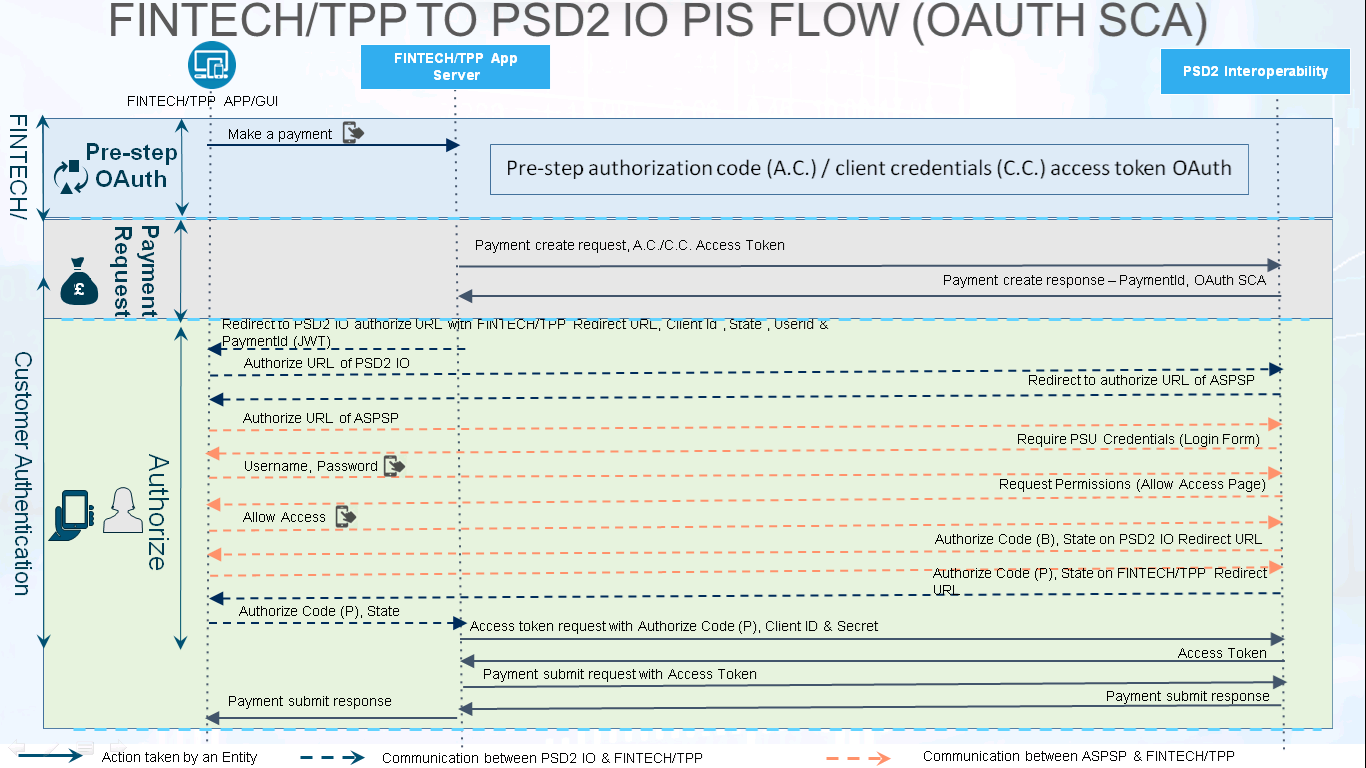
Step 1: Pre-step OAuth
- PSU will request to make a payment.
- Depends on destination bank, Fintech/TPP has to do a pre-step authorization_code (A.C.) / client_credentials (C.C.) access token Oauth.
Step 2: Create Payment
- Fintech/TPP will send the payment request with A.C / C.C. access token to PSD2 IO.
- PSD2 IO will return response containing PaymentId, OAuth SCA approach to Fintech/TPP.
Step 3: Authorize
- Fintech/TPP will redirect PSU to ‘/authorize’ URL with TPP Redirect URL, Client Id, State, UserId & PaymentId in JWT to authenticate the request id from PSU.
- PSU will get redirected to PSD2 IO authorize URL through browser.
- PSD2 IO will redirect PSU to ASPSP authorize URL through browser.
- ASPSP will redirect PSU to login page for authentication.
- PSU has to authenticate with his credentials on ASPSP’s login page.
- Once authenticated, ASPSP will ask to allow access for authorization.
- PSU will allow access.
- ASPSP will return auth code (B) & state on the callback URL of PSD2 IO.
- PSD2 IO will return auth code (P) & state on the callback URL of Fintech/TPP.
Step 4: Access Token
- Fintech/TPP will call the ‘/token’ API of PSD2 IO with auth code (P) received on callback.
- PSD2 IO will return the access token to Fintech/TPP.
Step 5: Submit Payment
This step needs to be exceuted only if value of PaymentFlow field in GET /banks API is TwoStep.
- Fintech/TPP will call payment submit API using the access token received.
- PSD2 IO will give the response to Fintech/TPP.
- Fintech/TPP will show the response to PSU on Fintech/TPP UI.
Redirect SCA
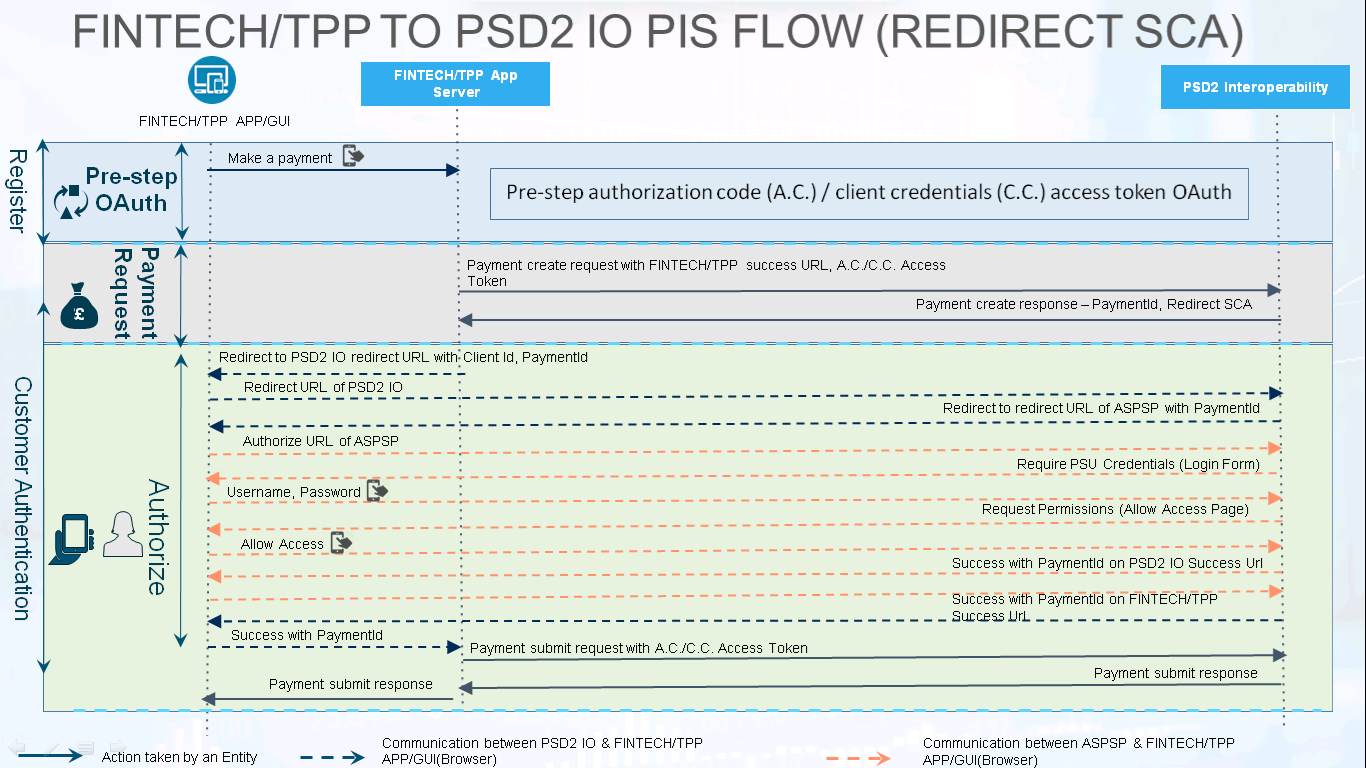
Step 1: Pre-step OAuth
- PSU will request to make a payment.
- Depends on destination bank, Fintech/TPP has to do a pre-step authorization_code (A.C.) / client_credentials (C.C.) access token Oauth.
Step 2: Create Payment
- Fintech/TPP will send the payment request with A.C / C.C. access token to PSD2 IO.
- PSD2 IO will return response containing PaymentId, OAuth SCA approach to Fintech/TPP.
Step 3: Redirect
- Fintech/TPP will redirect PSU to ‘/redirect’ URL with Client Id, PaymentId to authenticate the PaymentId from PSU.
- PSU will get redirected to PSD2 IO redirect URL through browser.
- PSD2 IO will redirect PSU to ASPSP redirect URL through browser.
- ASPSP will redirect PSU to login page for authentication.
- PSU has to authenticate with his credentials on ASPSP’s login page.
- Once authenticated, ASPSP will ask to allow access for authorization.
- PSU will allow access.
- ASPSP will return success along with PaymentId on the success URL of PSD2 IO.
- PSD2 IO will return success along with PaymentId on the success URL of Fintech/TPP.
Step 4: Submit Payment
This step needs to be exceuted only if value of PaymentFlow field in GET /banks API is TwoStep.
- Fintech/TPP will call payment submit API using the A.C./C.C access token received.
- PSD2 IO will give the response to Fintech/TPP.
- Fintech/TPP will show the response to PSU on Fintech/TPP UI.
Embedded SCA
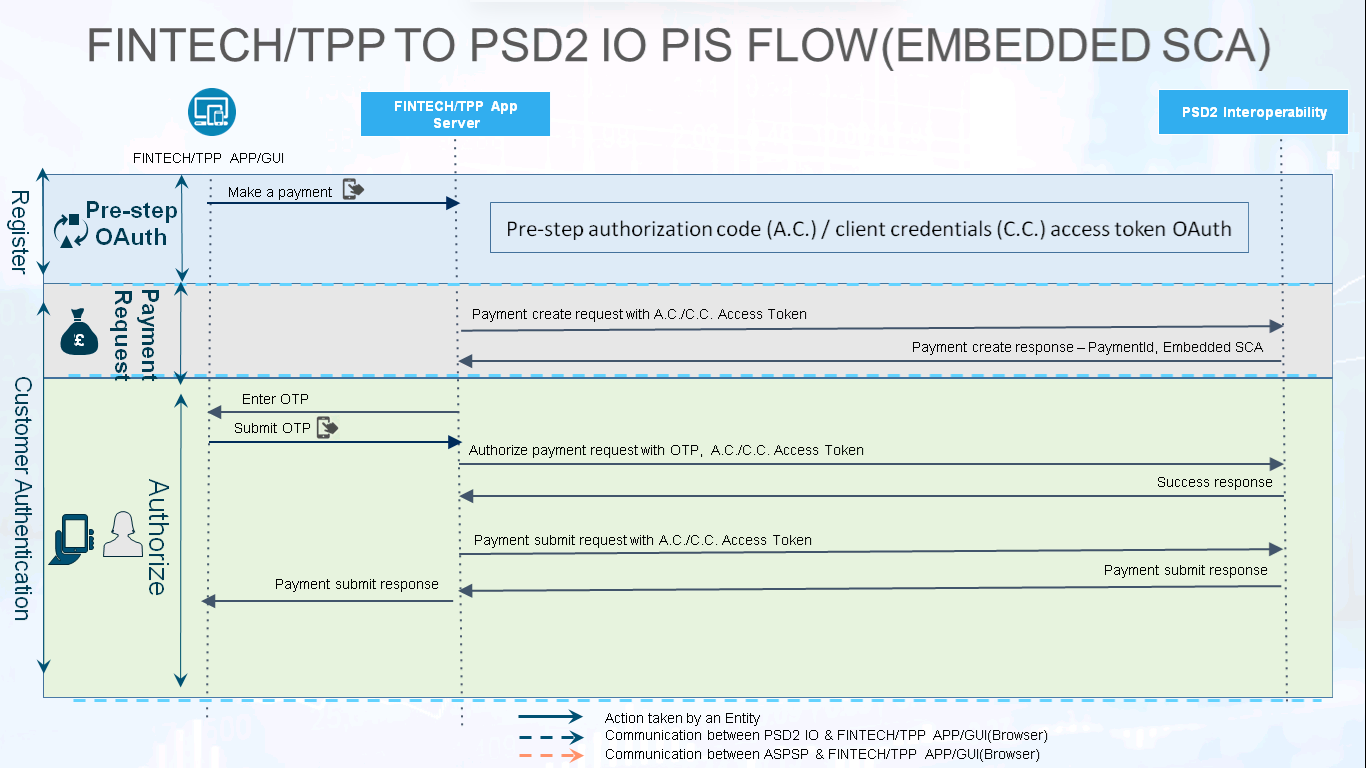
Step 1: Pre-step OAuth
- PSU will request to make a payment.
- Depends on destination bank, Fintech/TPP has to do a pre-step authorization_code (A.C.) / client_credentials (C.C.) access token Oauth.
Step 2: Create Payment
- Fintech/TPP will send the payment request with A.C / C.C. access token to PSD2 IO.
- PSD2 IO will return response containing PaymentId, OAuth SCA approach to Fintech/TPP.
Step 3: Embedded SCA
- Fintech/TPP will ask PSU to provide answer of the challenge received in the payment create response. Here for e.g.: OTP is taken.
- PSU will enter and submit the challenge data e.g.: OTP
- Fintech/TPP will call authorize payment API with the A.C./C.C. access token, challenge data e.g. OTP.
- PSD2 IO will give the response to Fintech/TPP.
Step 4: Submit Payment
This step needs to be exceuted only if value of PaymentFlow field in GET /banks API is TwoStep.
- Fintech/TPP will call payment submit API using the A.C./C.C access token received.
- PSD2 IO will give the response to Fintech/TPP.
- Fintech/TPP will show the response to PSU on Fintech/TPP UI.
Embedded SCA with SCA Method Selection
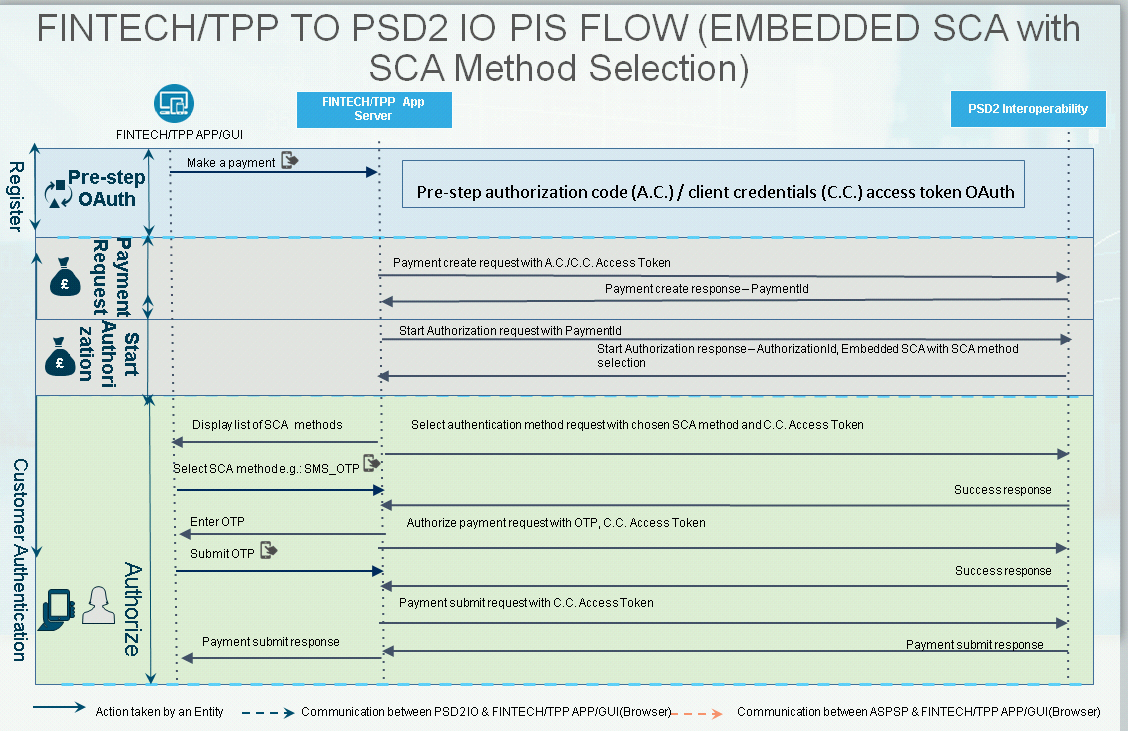
Step 1: Pre-step OAuth
- PSU will request to make a payment.
- Depends on destination bank, Fintech/TPP has to do a pre-step authorization_code (A.C.) / client_credentials (C.C.) access token Oauth.
Step 2: Create Payment
- Fintech/TPP will send the payment request with A.C / C.C. access token to PSD2 IO.
- PSD2 IO will return response containing PaymentId, OAuth SCA approach to Fintech/TPP.
Step 3: Start Authorization
- Fintech/TPP will send the start Authorization request with PaymentId to PSD2 IO.
- PSD2 IO will return response containing AuthorizationId with SCA method selection to Fintech/TPP.
Step 4: Embedded SCA with SCA Method Selection
- Fintech/TPP will ask PSU to select SCA method out of those received in the response.
- PSU will select the SCA method.
- Fintech/TPP will call select authentication API using the A.C./C.C. access token and selected SCA method.
- PSD2 IO will give the response to Fintech/TPP.
- Fintech/TPP will ask PSU to provide answer of the challenge received in the select authentication API response. Here for e.g.: OTP is taken.
- PSU will enter and submit the challenge data e.g.: OTP
- Fintech/TPP will call authorize payment API with the A.C./C.C. access token, challenge data e.g. OTP.
- PSD2 IO will give the response to Fintech/TPP.
Step 5: Submit Payment
This step needs to be exceuted only if value of PaymentFlow field in GET /banks API is TwoStep.
- Fintech/TPP will call payment submit API using the A.C./C.C access token received.
- PSD2 IO will give the response to Fintech/TPP.
- Fintech/TPP will show the response to PSU on Fintech/TPP UI.
Decoupled SCA

Step 1: Pre-step OAuth
- PSU will request to make a payment.
- Depends on destination bank, Fintech/TPP has to do a pre-step authorization_code (A.C.) / client_credentials (C.C.) access token Oauth.
Step 2: Create Payment
- Fintech/TPP will send the payment request with A.C / C.C. access token to PSD2 IO.
- PSD2 IO will return response containing PaymentId, OAuth SCA approach to Fintech/TPP.
Step 3: Authorize payment on ASPSP application
- Fintech/TPP will show the message to PSU to authorize the payment on ASPSP application.
- PSU will authorize the payment on the ASPSP application.
- PSD2 IO will return success along with PaymentId on the success URL of Fintech/TPP.
Step 4: Submit Payment
This step needs to be exceuted only if value of PaymentFlow field in GET /banks API is TwoStep.
- Fintech/TPP will call payment submit API using the A.C./C.C access token received.
- PSD2 IO will give the response to Fintech/TPP.
- Fintech/TPP will show the response to PSU on Fintech/TPP UI.
Decoupled SCA with Update Identification
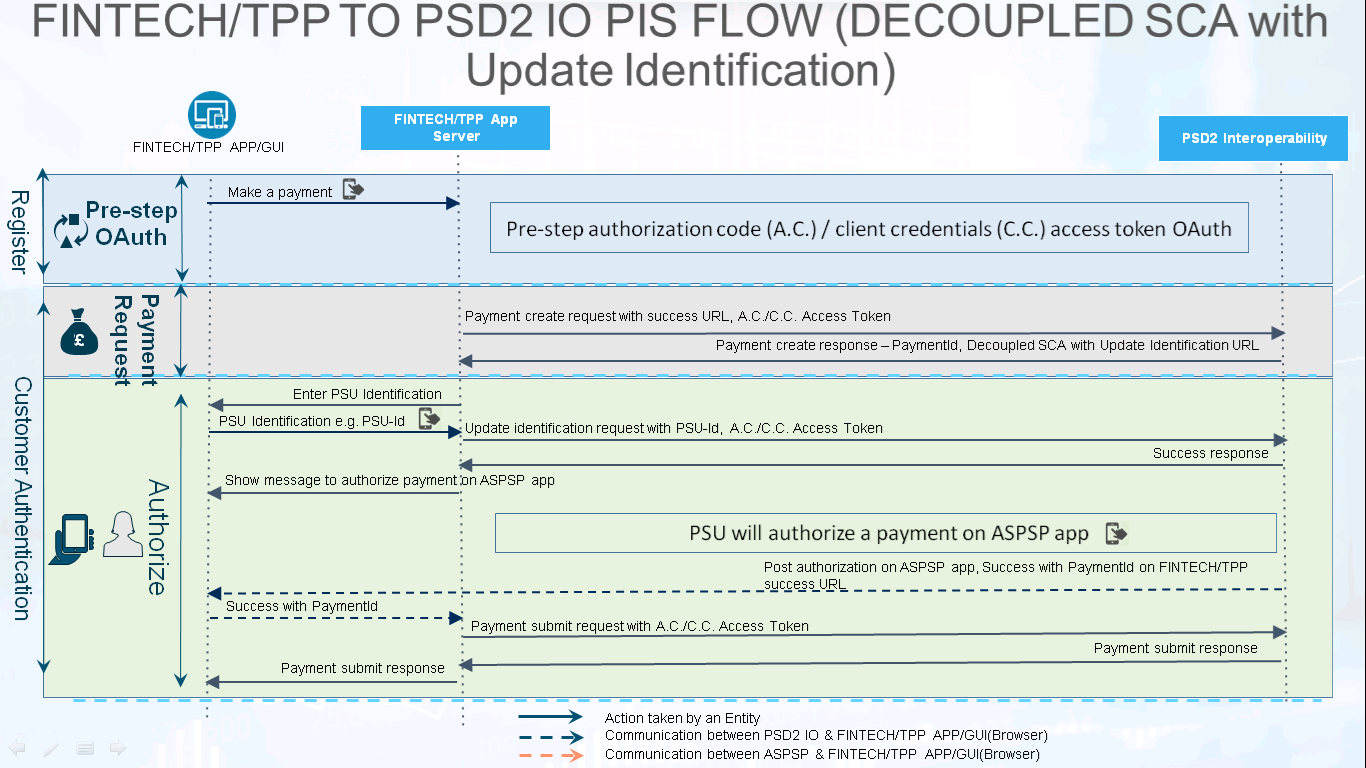
Step 1: Pre-step OAuth
- PSU will request to make a payment.
- Depends on destination bank, Fintech/TPP has to do a pre-step authorization_code (A.C.) / client_credentials (C.C.) access token Oauth.
Step 2: Account Access Consent Request
- Fintech/TPP will send the payment request with A.C / C.C. access token to PSD2 IO.
- PSD2 IO will return response containing PaymentId, OAuth SCA approach to Fintech/TPP.
Step 3: Decoupled SCA with Update Identification
- PP will ask PSU to update his identification data.
- PSU will enter his identification data e.g. PSU-Id.
- Fintech/TPP will call update identification API with the PSU identification data, C.C. access token
- PSD2 IO will give the response to Fintech/TPP.
Step 4: Authorize payment on ASPSP application
- Fintech/TPP will show the message to PSU to authorize the payment on ASPSP application.
- PSU will authorize the payment on the ASPSP application.
- PSD2 IO will return success along with PaymentId on the success URL of Fintech/TPP.
Step 5: Submit Payment
This step needs to be exceuted only if value of PaymentFlow field in GET /banks API is TwoStep.
- Fintech/TPP will call payment submit API using the A.C./C.C access token received.
- PSD2 IO will give the response to Fintech/TPP.
- Fintech/TPP will show the response to PSU on Fintech/TPP UI.
